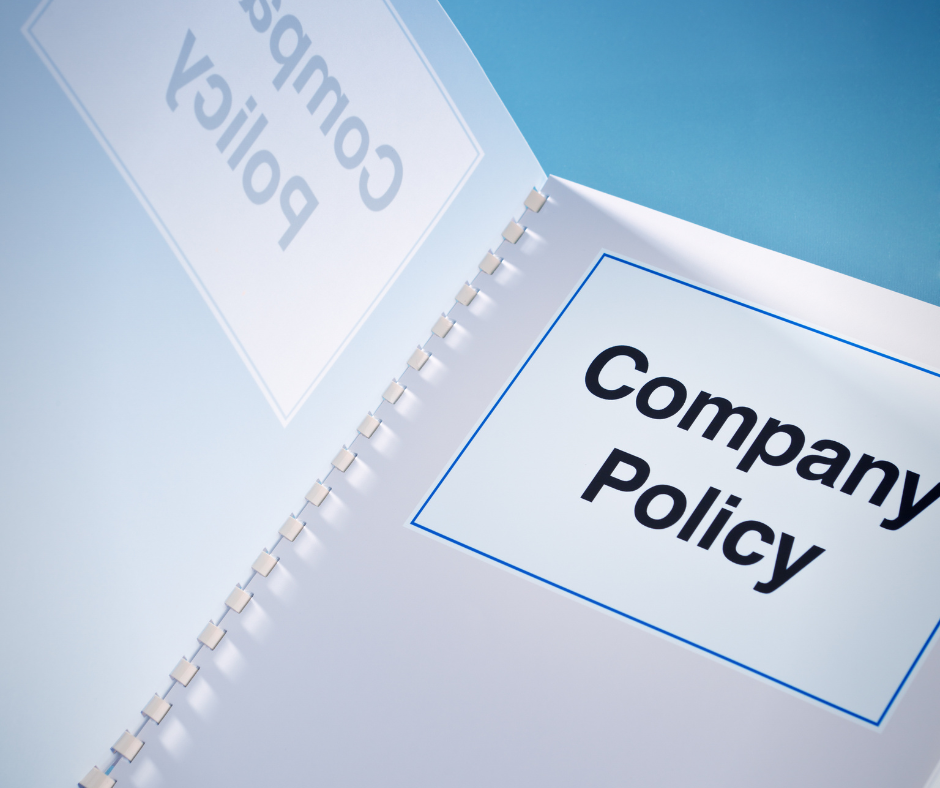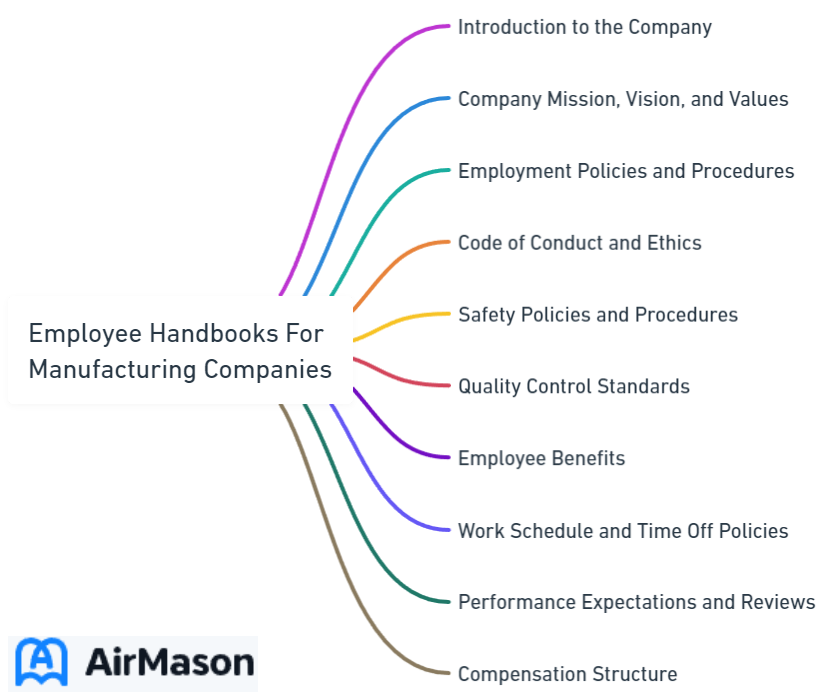
Key Takeaway:
- An employee handbook is an essential tool for manufacturing companies as it outlines policies, procedures and protocols that govern employee behavior, promoting consistency, and workplace harmony.
- A successful employee handbook should contain four key components including detailed company policies and procedures, health and safety protocols, code of conduct and ethical standards, and comprehensive benefits and compensation packages to ensure that employees understand expectations and incentives in the workplace.
- Creating and maintaining an effective employee handbook involves periodically reviewing and updating the document to reflect changes in regulation and corporate policies, ensuring that the handbook is legally compliant, and ensuring that it is accessible to all employees, including those with disabilities.
Are you a manufacturing company looking for a comprehensive, yet easy-to-follow employee handbook? You’ve come to the right place! This article explains the importance of employee handbooks, provides tips to make sure yours is up to date and relevant, and offers step-by-step guidance on how to create one.

Importance of Employee Handbooks for Manufacturing Companies
Employee Handbooks: Ensuring Uniformity and Safety in Manufacturing Companies
Employee handbooks play a crucial role in manufacturing companies by outlining procedures, policies, and responsibilities that enable a streamlined work environment. Manufacturing companies must maintain an organized and safe workplace, making employee handbooks a critical tool.
A well-written handbook ensures that employees understand their roles and responsibilities in the company, helping to increase productivity and minimize conflicts. Further, handbooks may include safety guidelines for employees dealing with hazardous equipment while promoting an organization’s culture and ethics. Employee handbooks for Merchant Wholesalers and Durable Goods companies, for instance, should cover the unique aspects of the industry. The handbook should specify procedures for dealing with chemical spills and other potential hazards while also outlining policies for equipment maintenance and repair, and COVID-19 guidelines. According to the National Safety Council, manufacturing industries account for 15% of all workplace fatalities in the US. Employee handbooks can significantly reduce such fatalities by specifying procedures for handling hazardous situations and ensuring employees follow proper safety protocol.

Components of an Effective Employee Handbook
Ensure your manufacturing firm has a successful employee handbook. Include:
- company policies and procedures
- health and safety protocols
- ethical standards and code of conduct
- benefits and compensation packages
This will make sure your employees comprehend your expectations and rules.
Company policies and procedures
The set of rules and regulations that an organization follows to maintain discipline and coherence among its members is a crucial aspect of any employee handbook. These codes of conduct are commonly referred to as ‘Organizational Directives’, which outline the policies and procedures that need to be adhered to by each employee.
These directives are significant in providing clarity on several aspects of business, including human resource management, internal communication, organizational structure, etc. They describe the responsibilities and accountabilities for different roles within the company. The consistent application of policies and procedures can help reduce exposure to legal liability.
Reputable manufacturing companies have incorporated environmental, health, and safety (EHS) policies within their directives. Adhering to these guidelines ensures protection for both employees and the environment against exposure from hazardous practices or materials. For instance, ABC Manufacturing witnessed a decline in work-related injuries after implementing safety protocols in 2019. The company made EHS part of its organizational directive’s code of conduct. These policies illustrated the necessary steps needed before starting any industrial process or handling hazardous pieces of equipment. Learn more about top 5 questions about employee handbooks for manufacturing companies. If you think health and safety protocols are boring, just wait until you have to deal with a workplace injury lawsuit.
Health and safety protocols
The safety protocols implemented by Manufacturing companies in their employee handbooks are crucial. As the workforce is exposed to various dangers on the job, safeguarding employees should be a priority. Manufacturing companies implement safety protocols such as the use of protective gear, mandatory training and periodical equipment inspections, machine usage guidelines, and reporting procedures for any accidents or incidents that occur in the workplace.
It’s essential to ensure that these protocols are strictly followed to minimize workplace accidents that can cause severe injuries and fatalities. In case of non-compliance with these protocols can lead to disciplinary action up to termination of employment.
Fun fact: According to OSHA, “in 2019, approximately 271000 work-related traumatic injuries occurred in manufacturing settings.” Remember, if it’s not in the employee handbook, it didn’t happen – and if it’s not ethical, it shouldn’t be happening anyway.
Code of conduct and ethical standards
Maintaining an ethical work environment in a manufacturing company is crucial for its reputation. Clear communication of employee behaviors and conduct ethics can be delivered using an Employee Handbook. This guideline can enforce compliance to rules and promote ethical standards of employees. Each employee should comply with the organization’s code of conduct, which outlines their expected behavior within the company premises and proper usage of supplies and equipment. They must follow all policies, regulations, laws with integrity and honesty while providing high-quality services. The code of conduct in the handbook emphasizes key principles such as confidentiality, conflict-of-interests, bribery prevention, discrimination prohibition, harassment prevention that ensures a healthy work culture. It also serves as a reference point for reviews or disciplinary actions by HR representatives. For more information on creating effective employee handbooks for manufacturing companies, check out this handbook template that can also be customized for your restaurant’s needs. According to Society for Human Resource Management (SHRM), manufacturing companies face several legal issues regarding labor legislation. Employers try to make their staff aware of these factors, such as anti-discrimination laws like the Equal Employment Opportunity Commission (EEOC) or National Labor Relations Board (NLRB) guidelines for unionized shops. A well-thought-out employee handbook stating unambiguous rules and regulations will safeguard the interests of both employers and employees. Here are six tips to make an employee handbook that employees will actually read, ensuring that all parties involved are on the same page and informed about company policies. “Working here may not make you rich, but at least we’ll give you enough benefits to keep you healthy and happy.”
Benefits and compensation packages
This section elaborates on the remunerative and non-financial offerings provided to employees.
- Salaries, bonuses, and incentives: Explain the pay scale structure, bonus policy, and perks.
- Retirement Benefits: Describe the insurance policies available for employees as per state laws.
- Medical Insurance and Leave Policies: One of the best tips for creating an employee handbook is to outline the medical insurance plan coverage options along with paid time-off policies (sick leave, bereavement leave).
- Educational support: Mention any tuition reimbursement programs offered by the company for employees looking to upskill or earn advanced degrees.
- Wellness Programs: Detail any initiatives or resources available to encourage healthy lifestyles among employees such as gym memberships, mental health programs, etc.
Additionally, manufacturing companies may offer unique benefits like on-site childcare or transportation services. A certain company offered a profit-sharing program where a portion of profits was distributed among high-performing employees. This not only boosted morale but also helped in retaining valuable talent within the organization.
Creating an employee handbook is like assembling furniture – it’s frustrating, time-consuming, but necessary for a functional workplace.

Best Practices for Creating and Maintaining Employee Handbooks
Your manufacturing company must adopt best practices for their employee handbook. This includes:
- Reviewing and updating regularly.
- Legal compliance.
- Accessibility for all employees.
This way, the handbook will stay current, steer clear of potential legal issues, and be available to all your employees.
Reviewing and updating regularly
Regular Assessment and Updating of Employee Handbooks Employee handbooks are a company’s policies and procedures guidebook, providing necessary information to employees about the company culture, expectations, and benefits. These handbooks must be continuously reviewed and updated to ensure compliance with company policies and laws governing employment practices. It is essential to assess the current state of the handbook periodically. Identify areas of changes in business operations or legislation, which may need amendments in handbook content. Informative language that aligns with cultural standards should be used while updating. Learn more about creating an employee handbook for manufacturing companies. Regular updates of employee handbooks are vital as they provide clarity on the latest legal requirements regarding labor laws, processes such as recruiting, communication initiatives like remote working policies. Minimizing uncertainties brings value to your company while reducing any possible liability claims. Employees rely on this handbook to understand their rights, recognize acceptable behavior within the workplace. An outdated or inaccurate one can lead to negative outcomes for both parties involved – damage in reputation besides potential law suit issues. An employee handbook can have a significant impact on how employees view their employment experience with your organization. To maintain an engaged workforce, keeping employees happy and performing well is necessary. By having an updated handbook that follows industry-leading best practices, manufacturing companies can ensure high-quality performance from employees with satisfaction levels that boost loyalty towards leadership. For companies in the hospitality industry, such as restaurants and bars, there are key considerations that must be included in the employee handbook to ensure compliance with regulations and provide clear expectations for employees. Legal compliance may sound boring, but skipping it will leave your company in hot water faster than a factory worker’s coffee.
Ensuring legal compliance
One of the essential aspects of creating and maintaining employee handbooks is ensuring legal compliance. Meeting labor regulations in manufacturing companies requires a comprehensive understanding of state, federal, and international laws. To effectively achieve legal compliance, it is crucial to include information on:
- labor standards
- anti-discrimination policies
- wage and hour laws
- safety procedures
- benefits packages for employees.
Non-compliance with these regulations often results in penalties and legal action against the employer. Creating an employee handbook that adheres to these regulations significantly minimizes the risk of liability. It’s also important to regularly update your handbook to reflect any changes in laws or company policies. In addition to accurately reflecting the applicable laws and regulations in your employee handbook, it is necessary to train your management personnel on how to implement relevant policies properly. They should understand their role in overseeing compliance within their departments and know how to respond appropriately if there is an issue. If you are creating an employee handbook, it is important to know where to start. By prioritizing legal compliance in employee handbooks for manufacturing companies, employers can take measures that protect their workforce while minimizing any potential financial and reputational risks associated with non-compliance. Don’t miss out on the critical importance of meeting labor regulation requirements when creating an employee handbook for your manufacturing company. Ignoring these essential components could result in serious legal consequences that are entirely avoidable through proper adherence. Learn what to include in an employee handbook for your manufacturing company to ensure compliance and protect your business. Because discrimination is not just bad PR, it’s also illegal – make your employee handbook accessible to everyone, even those who refuse to wear their reading glasses.
Ensuring accessibility to all employees
Employee handbooks must be designed to ensure that all employees can access them easily. This can be achieved by creating multiple accessible formats, such as braille or audio recordings. Additionally, providing translations in different languages is also essential for non-native speakers. To further increase accessibility, handbooks should utilize clear and concise language with a logical format to aid comprehension. Regular updates and reviews by legal professionals uphold compliance with legislative requirements and maintain accuracy. Finally, consideration should be given to those who may experience difficulties accessing the internet or electronic devices Providing hard copies of the handbook allows all employees equal access to information. What does an employee handbook say about a company? According to SHRM (Society for Human Resource Management), over 95% of companies currently use employee handbooks in the United States.
Five Facts About Employee Handbooks for Manufacturing Companies:
- Employee handbooks for manufacturing companies typically include policies on safety, attendance, dress code, and performance expectations. (Source: HR Technologist)
- These handbooks may also cover topics such as harassment, discrimination, and whistleblower protection, as well as benefits and compensation. (Source: Manufacturing.net)
- An effective handbook can help manufacturing companies reduce legal risks and ensure consistency in their policies and procedures. (Source: HR Daily Advisor)
- It is important for these handbooks to be regularly reviewed and updated to reflect changes in laws and regulations. (Source: Entrepreneur)
- Providing employees with a comprehensive and clearly written handbook can also improve employee morale and engagement. (Source: Business.com)
FAQs about Employee Handbooks For Manufacturing Companies
What is an Employee Handbook for Manufacturing Companies?
An employee handbook for manufacturing companies is a document that outlines important policies, procedures, and guidelines that employees must adhere to while working in a manufacturing company. It contains information on employee benefits, workplace regulations, safety and security protocols, and more.
Why is an Employee Handbook Necessary for Manufacturing Companies?
An employee handbook is necessary for manufacturing companies to communicate their expectations and policies to their employees. It acts as a reference guide for employees and helps ensure that everyone in the company is on the same page. It also provides protection for the company in case of legal disputes.
What should be included in an Employee Handbook for Manufacturing Companies?
An employee handbook for manufacturing companies should include information on company policies, employee benefits, workplace regulations, safety and security protocols, and more. It should also include information on employee responsibilities and conduct, disciplinary procedures, and company values.
How often should an Employee Handbook be updated?
An employee handbook should be reviewed and updated regularly. The frequency at which it should be updated depends on changes in company policies, relevant laws and regulations, and industry standards. As a general rule, it is recommended to review and update the handbook at least once a year.
Can an Employee Handbook be used as a Legal Document?
Yes. An employee handbook can be used as a legal document and can be used as evidence in legal disputes. However, it is important to note that an employee handbook should not be a substitute for legal advice and should be reviewed by a legal professional before being implemented.
How can I ensure that my Employee Handbook is Effective?
To ensure that your employee handbook is effective, you should involve your employees in the process of creating and updating it. You should also ensure that the contents are clear, concise, and easily accessible to all employees. Finally, it is important to review and update the handbook regularly to ensure that it remains relevant and useful.
